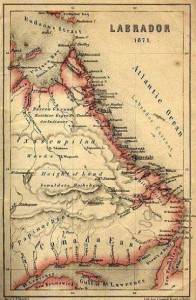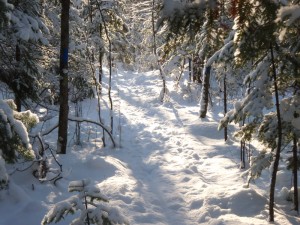 Three men dip their paddles into the calm waters of the remote lake and move their canoe up a relatively small inlet. The year is 1903. The lake is Grand Lake, a gateway into the unmapped and untraveled wilderness of Labrador. Their plan is to canoe and portage their way 600 miles west and north to Northwest Post on the Hudson Bay, a heretofore unattempted journey. They do not realize it, of course, but a mere 2 days and 40 miles into their trip, they are making the journey’s most pivotal decision — one that will lead beyond failure to disaster — and for one of them, death by starvation.
Three men dip their paddles into the calm waters of the remote lake and move their canoe up a relatively small inlet. The year is 1903. The lake is Grand Lake, a gateway into the unmapped and untraveled wilderness of Labrador. Their plan is to canoe and portage their way 600 miles west and north to Northwest Post on the Hudson Bay, a heretofore unattempted journey. They do not realize it, of course, but a mere 2 days and 40 miles into their trip, they are making the journey’s most pivotal decision — one that will lead beyond failure to disaster — and for one of them, death by starvation.
Great Heart: History of a Labrador Adventure by Davidson and Rugge is an account of this journey, as well as of two subsequent journeys through the wild interior of Labrador by canoe.
One thing that strikes me is their decision to head upriver from the inlet without more fully exploring the northern end of the lake, which in fact has three other major inlets. One of these is the Naskapi, the river they had intended to take. But it was approaching mid-July in the short Labrador summer, and their journey had already been delayed by several weeks. The river they had chosen seemed to fit their map and the vague descriptions from local trappers well enough. In the next few days, as they paddled farther, the river became unexpectedly shallow, steep, and rocky, forcing frequent portages.
Had circumstances been different, they might have re-thought their route. Instead, they continued on for 60 days and 150 miles through an impossible landscape of steep hills, wide swamps, and thick forests. In mid-September, after almost uncountable miles of portaging their heavy gear, they spent several days windbound on a lakeshore and finally turned back. By this time, their food supplies were exhausted, the rough country had torn their clothing to shreds, and they were dangerously thin from physical exertion and a lean diet. Temperatures were dropping; game and fish were more scarce. Their retreat became a race against winter and starvation. Two of the men managed to make their way back to the starting point. The third, Leonidas Hubbard, the leader of the expedition, died of a combination of starvation and (likely) hypothermia.
The title of this post intends no disrespect toward members of the Hubbard Expedition. The mistake they made could have been made by any of us. The information they had told of a river leading out of the northern end of Grand Lake. The first river they came to was that river — this was the conclusion they leapt to. The maps of the time were made up largely of blank spaces when it came to interior Labrador. When the map did not conform to the territory they saw in front of them, they mentally willed the territory to conform to the map.
Their story has lessons for all of us who venture into the unknown, whether it be taking a back road to cut across town, guessing left at a fork in a hiking trail, or guessing right at a confluence of two rivers. Their refusal to turn back, despite mounting evidence that they had taken a “wrong turn” followed stages many of us are familiar with.
First, there is absolute belief that we have chosen the correct route. During this stage, any signs to the contrary are ignored. If the map has led us to expect a river and we find a stream, we stretch our mental construct such that it becomes a “small river” and continue. In the second stage, our denial deepens. We begin to have doubts, but we keep on, telling ourselves if we go just a little farther, the landmarks we were anticipating will appear, and the visible landscape will begin to conform more closely with our expectations. Stage 3 involves accepting that we probably have taken a wrong turn. Not wanting to retreat, we bargain. Just go a little farther, we coach ourselves, and we will have more complete proof that we are in the wrong. Stage 4 involves certainty. We know we are wrong. But we have come so far already that turning back has a significant cost. Better to keep going and hope for a stroke of luck. Maybe we will yet come out of this better than we have a right to hope.
Most of us have been there. Most of us will be there again. In this era of Google Earth, it is more tempting than ever to think that map and territory are one in the same. The map is not a physical thing though; it is a mental construct. It is what we can hold in our heads. The territory is something altogether different. And that is why we go there. We go to have our preconceptions shattered. We go to have better maps.
Great Heart is a story about human stubbornness; it is also a tale of ambition and courage. Most of us who seek adventure in the outdoors will be able to see ourselves making the same decisions made by these men, and that is part of what makes this journey so gripping.
Resources:
Wildernesscanoe.org has information and links on the 1903 Hubbard Expedition as well as on the 2003 Centennial Expedition. Maps of Labrador showing the routes of various expeditions are at Basicoutdoors.com

